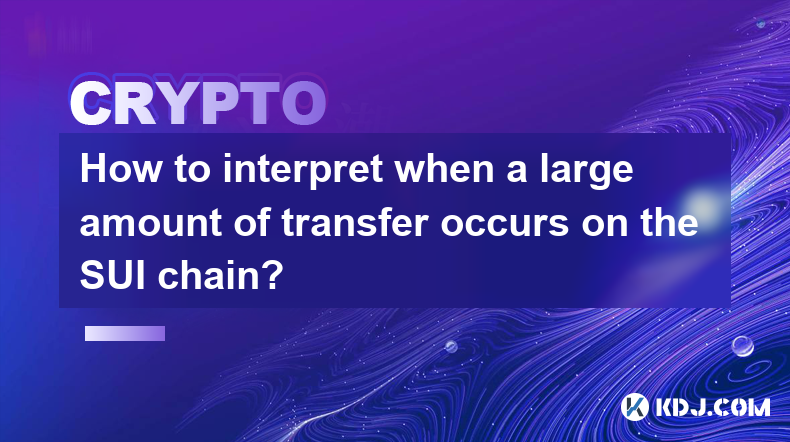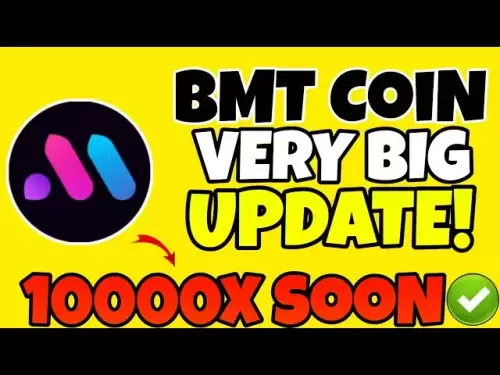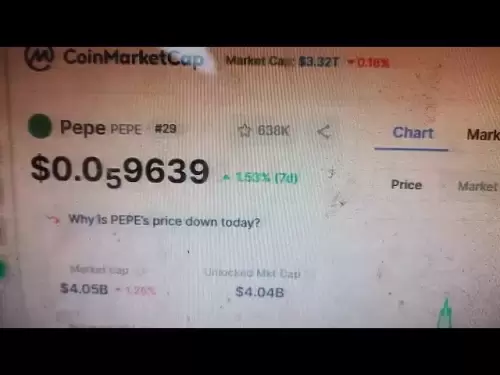-
 Bitcoin
Bitcoin $108,962.3544
0.69% -
 Ethereum
Ethereum $2,563.3189
1.78% -
 Tether USDt
Tether USDt $1.0003
0.00% -
 XRP
XRP $2.2768
2.22% -
 BNB
BNB $661.4562
0.97% -
 Solana
Solana $151.7146
2.47% -
 USDC
USDC $1.0000
0.00% -
 TRON
TRON $0.2847
0.18% -
 Dogecoin
Dogecoin $0.1713
4.43% -
 Cardano
Cardano $0.5848
1.78% -
 Hyperliquid
Hyperliquid $39.5345
-0.06% -
 Sui
Sui $2.9384
1.25% -
 Bitcoin Cash
Bitcoin Cash $492.0864
1.54% -
 Chainlink
Chainlink $13.4271
1.89% -
 UNUS SED LEO
UNUS SED LEO $9.0294
0.07% -
 Avalanche
Avalanche $18.1886
1.61% -
 Stellar
Stellar $0.2430
2.48% -
 Toncoin
Toncoin $2.9054
6.05% -
 Shiba Inu
Shiba Inu $0.0...01186
3.57% -
 Litecoin
Litecoin $88.0187
1.46% -
 Hedera
Hedera $0.1574
1.38% -
 Monero
Monero $315.1335
0.11% -
 Polkadot
Polkadot $3.3994
1.47% -
 Dai
Dai $1.0000
0.00% -
 Ethena USDe
Ethena USDe $1.0002
0.01% -
 Bitget Token
Bitget Token $4.4220
0.86% -
 Uniswap
Uniswap $7.4330
7.03% -
 Pepe
Pepe $0.0...01010
4.10% -
 Aave
Aave $277.8377
2.41% -
 Pi
Pi $0.4572
-0.22%
How to interpret when a large amount of transfer occurs on the SUI chain?
Large SUI chain transfers can signal market shifts; tracking them with blockchain explorers and analytics tools helps interpret their impact on price and liquidity.
Apr 27, 2025 at 06:28 am

When a large amount of transfer occurs on the SUI chain, it can be a significant event for various stakeholders within the cryptocurrency ecosystem. Understanding the implications and interpreting the reasons behind such transfers can provide valuable insights into market dynamics, investor behavior, and potential future trends. In this article, we will delve into the various aspects of interpreting large transfers on the SUI chain, including what they signify, how to track them, and what actions one might consider taking in response.
Understanding Large Transfers on the SUI Chain
Large transfers on the SUI chain can occur for several reasons, each carrying different implications for the market. A large transfer might indicate a whale moving their assets, which could be a precursor to significant market movements. Alternatively, it could be a transfer between exchanges, reflecting liquidity adjustments or rebalancing of portfolios. Additionally, large transfers might be associated with institutional investments or withdrawals, signaling shifts in investor sentiment.
To accurately interpret these transfers, it's crucial to consider the context and the source and destination of the funds. Transfers from a known institutional wallet to an exchange might suggest an upcoming sell-off, whereas transfers from an exchange to a private wallet could indicate long-term holding intentions.
Tracking Large Transfers on the SUI Chain
Tracking large transfers on the SUI chain involves using blockchain explorers and analytics tools designed for cryptocurrency transactions. Here are the steps to track such transfers:
- Choose a reliable blockchain explorer: Select a blockchain explorer that supports the SUI chain, such as SUI Explorer or any other compatible platform.
- Set up transaction filters: Use the explorer's filtering options to focus on transactions above a certain threshold. For example, you might set the filter to show transactions exceeding 10,000 SUI.
- Analyze the transaction details: Once you identify a large transfer, examine the transaction hash, sender's address, recipient's address, and the timestamp. This information helps in understanding the nature of the transfer.
- Use additional analytics tools: Platforms like Nansen or Glassnode can provide deeper insights into the addresses involved, helping you determine if they belong to known entities like exchanges or institutional investors.
By consistently monitoring these transfers, you can gain a better understanding of the flow of funds within the SUI ecosystem.
Interpreting the Impact on Market Dynamics
Large transfers on the SUI chain can have several impacts on market dynamics. If a whale moves a significant amount of SUI to an exchange, it might lead to increased selling pressure, potentially causing a dip in the price. Conversely, if large amounts of SUI are moved to private wallets, it might signal a decrease in available supply on exchanges, which could lead to a price increase if demand remains constant.
Additionally, large transfers between exchanges can indicate arbitrage opportunities, where traders exploit price differences between platforms. Observing these movements can provide insights into market efficiency and liquidity.
Responding to Large Transfers
When you observe a large transfer on the SUI chain, consider the following actions:
- Monitor price movements: Keep an eye on the SUI price after the transfer. Sudden price changes might confirm the impact of the transfer.
- Analyze market sentiment: Use social media and forums to gauge the community's reaction to the transfer. Sentiment can influence market movements.
- Adjust trading strategies: Based on your interpretation of the transfer, you might decide to buy, sell, or hold SUI. For example, if you believe a large transfer to an exchange signals a sell-off, you might consider selling your holdings or shorting SUI.
Case Studies of Large Transfers on the SUI Chain
Examining past large transfers on the SUI chain can provide valuable lessons. For instance, a transfer of 1 million SUI from a known institutional wallet to an exchange in January 2023 was followed by a 5% price drop. This example illustrates how institutional moves can influence market prices.
Another case involved a transfer of 500,000 SUI from an exchange to a private wallet in March 2023, which coincided with a period of price stabilization. This suggests that the transfer might have been part of a strategy to reduce selling pressure and stabilize the market.
Tools and Resources for Tracking Large Transfers
Several tools and resources are available to help track and interpret large transfers on the SUI chain:
- SUI Explorer: A primary tool for viewing transactions on the SUI blockchain.
- Nansen: Offers detailed analytics on blockchain transactions, including wallet labeling and transaction flow.
- Glassnode: Provides on-chain data and insights that can help interpret large transfers.
- CryptoQuant: Useful for tracking exchange flows and understanding the impact of large transfers on liquidity.
Utilizing these tools can enhance your ability to interpret and respond to large transfers effectively.
Frequently Asked Questions
Q: Can large transfers on the SUI chain be manipulated to influence the market?
A: While it is possible for large transfers to be used to manipulate the market, such actions are typically illegal and subject to regulatory scrutiny. Most large transfers are legitimate movements of funds for various purposes, such as portfolio rebalancing or institutional investments.
Q: How can I differentiate between a whale transfer and an exchange transfer on the SUI chain?
A: To differentiate between a whale transfer and an exchange transfer, you can use blockchain analytics tools like Nansen or Glassnode. These platforms often label known addresses, allowing you to identify whether the transfer involves a whale or an exchange.
Q: Are there any legal implications of tracking large transfers on the SUI chain?
A: Tracking large transfers on the SUI chain is generally legal and is part of standard market analysis. However, using the information to engage in illegal activities, such as market manipulation or insider trading, can have serious legal consequences.
Q: How frequently should I check for large transfers on the SUI chain?
A: The frequency of checking for large transfers depends on your trading strategy and market involvement. For active traders, checking daily or even multiple times a day can be beneficial. For long-term investors, weekly or bi-weekly checks might suffice.
Disclaimer:info@kdj.com
The information provided is not trading advice. kdj.com does not assume any responsibility for any investments made based on the information provided in this article. Cryptocurrencies are highly volatile and it is highly recommended that you invest with caution after thorough research!
If you believe that the content used on this website infringes your copyright, please contact us immediately (info@kdj.com) and we will delete it promptly.
- Litecoin Breakout Watch: What Traders Need to Know Now
- 2025-07-06 16:50:13
- Bitcoin, Solana, Ethereum: Decoding the Latest Buzz on the Blockchain
- 2025-07-06 16:50:13
- Widnes Resident's 50p Could Be Your Ticket to Easy Street: Rare Coin Mania!
- 2025-07-06 16:55:13
- Bitcoin, Solaris Presale, and Token Rewards: What's the Buzz?
- 2025-07-06 16:55:13
- Ethereum Under Pressure: Price Drop Amid Global Uncertainties
- 2025-07-06 17:00:13
- XRP, SEC Case, and Prosperity: A New Era for XRP Holders?
- 2025-07-06 17:10:13
Related knowledge

How to customize USDT TRC20 mining fees? Flexible adjustment tutorial
Jun 13,2025 at 01:42am
Understanding USDT TRC20 Mining FeesMining fees on the TRON (TRC20) network are essential for processing transactions. Unlike Bitcoin or Ethereum, where miners directly validate transactions, TRON uses a delegated proof-of-stake (DPoS) mechanism. However, users still need to pay bandwidth and energy fees, which are collectively referred to as 'mining fe...

USDT TRC20 transaction is stuck? Solution summary
Jun 14,2025 at 11:15pm
Understanding USDT TRC20 TransactionsWhen users mention that a USDT TRC20 transaction is stuck, they typically refer to a situation where the transfer of Tether (USDT) on the TRON blockchain has not been confirmed for an extended period. This issue may arise due to various reasons such as network congestion, insufficient transaction fees, or wallet-rela...

How to cancel USDT TRC20 unconfirmed transactions? Operation guide
Jun 13,2025 at 11:01pm
Understanding USDT TRC20 Unconfirmed TransactionsWhen dealing with USDT TRC20 transactions, it’s crucial to understand what an unconfirmed transaction means. An unconfirmed transaction is one that has been broadcasted to the blockchain network but hasn’t yet been included in a block. This typically occurs due to low transaction fees or network congestio...

How to check USDT TRC20 balance? Introduction to multiple query methods
Jun 21,2025 at 02:42am
Understanding USDT TRC20 and Its ImportanceUSDT (Tether) is one of the most widely used stablecoins in the cryptocurrency market. It exists on multiple blockchain networks, including TRC20, which operates on the Tron (TRX) network. Checking your USDT TRC20 balance accurately is crucial for users who hold or transact with this asset. Whether you're sendi...

What to do if USDT TRC20 transfers are congested? Speed up trading skills
Jun 13,2025 at 09:56am
Understanding USDT TRC20 Transfer CongestionWhen transferring USDT TRC20, users may occasionally experience delays or congestion. This typically occurs due to network overload on the TRON blockchain, which hosts the TRC20 version of Tether. Unlike the ERC20 variant (which runs on Ethereum), TRC20 transactions are generally faster and cheaper, but during...

The relationship between USDT TRC20 and TRON chain: technical background analysis
Jun 12,2025 at 01:28pm
What is USDT TRC20?USDT TRC20 refers to the Tether (USDT) token issued on the TRON blockchain using the TRC-20 standard. Unlike the more commonly known ERC-20 version of USDT (which runs on Ethereum), the TRC-20 variant leverages the TRON network's infrastructure for faster and cheaper transactions. The emergence of this version came as part of Tether’s...

How to customize USDT TRC20 mining fees? Flexible adjustment tutorial
Jun 13,2025 at 01:42am
Understanding USDT TRC20 Mining FeesMining fees on the TRON (TRC20) network are essential for processing transactions. Unlike Bitcoin or Ethereum, where miners directly validate transactions, TRON uses a delegated proof-of-stake (DPoS) mechanism. However, users still need to pay bandwidth and energy fees, which are collectively referred to as 'mining fe...

USDT TRC20 transaction is stuck? Solution summary
Jun 14,2025 at 11:15pm
Understanding USDT TRC20 TransactionsWhen users mention that a USDT TRC20 transaction is stuck, they typically refer to a situation where the transfer of Tether (USDT) on the TRON blockchain has not been confirmed for an extended period. This issue may arise due to various reasons such as network congestion, insufficient transaction fees, or wallet-rela...

How to cancel USDT TRC20 unconfirmed transactions? Operation guide
Jun 13,2025 at 11:01pm
Understanding USDT TRC20 Unconfirmed TransactionsWhen dealing with USDT TRC20 transactions, it’s crucial to understand what an unconfirmed transaction means. An unconfirmed transaction is one that has been broadcasted to the blockchain network but hasn’t yet been included in a block. This typically occurs due to low transaction fees or network congestio...

How to check USDT TRC20 balance? Introduction to multiple query methods
Jun 21,2025 at 02:42am
Understanding USDT TRC20 and Its ImportanceUSDT (Tether) is one of the most widely used stablecoins in the cryptocurrency market. It exists on multiple blockchain networks, including TRC20, which operates on the Tron (TRX) network. Checking your USDT TRC20 balance accurately is crucial for users who hold or transact with this asset. Whether you're sendi...

What to do if USDT TRC20 transfers are congested? Speed up trading skills
Jun 13,2025 at 09:56am
Understanding USDT TRC20 Transfer CongestionWhen transferring USDT TRC20, users may occasionally experience delays or congestion. This typically occurs due to network overload on the TRON blockchain, which hosts the TRC20 version of Tether. Unlike the ERC20 variant (which runs on Ethereum), TRC20 transactions are generally faster and cheaper, but during...

The relationship between USDT TRC20 and TRON chain: technical background analysis
Jun 12,2025 at 01:28pm
What is USDT TRC20?USDT TRC20 refers to the Tether (USDT) token issued on the TRON blockchain using the TRC-20 standard. Unlike the more commonly known ERC-20 version of USDT (which runs on Ethereum), the TRC-20 variant leverages the TRON network's infrastructure for faster and cheaper transactions. The emergence of this version came as part of Tether’s...
See all articles

























































































